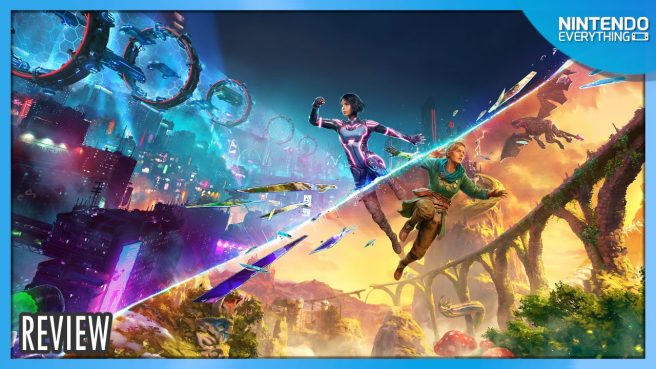Split Fiction review for Nintendo Switch 2
System: Switch 2
Release date: June 5, 2025
Developer: Hazelight Studios
Publisher: Electronic Arts
Generally, my wife does not play video games very often, as she’s always been more keen to cozy up with a good book and warm cup of tea during her free time. There are exceptions, of course – she did complete two 70+ hour playthrough of Hogwarts Legacy, to her credit – but for the most part, she simply hasn’t found many games that have piqued her interest. The only major exception to that trend is when a new game from Hazelight Studios comes out. She and I had a blast playing the studio’s previous two titles, A Way Out and It Takes Two, on the couch together over the past several years, and from time to time she would ask me if there was a sequel or something similar to those games that we could play. Needless to say, I was excited to learn that the studio’s next game, Split Fiction, would be a launch game for the Nintendo Switch 2, and was eager to put their latest genre-mashing, reality-shifting co-op adventure through its paces.
Split Fiction continues in the spirit of Hazelight Studios’ other recent titles in that it’s a narrative-driven action-adventure title that can only be played with another. If you’re playing through the game in couch co-op, it’s important to note that unlike some multiplayer titles, it’s not possible to play this one with a single Joy-Con turned on it’s side; each player will need a full set of Joy-Con 2 controllers, a Pro Controller, or an old Switch 1 controller. It’s also possible to play with friends online or via local wireless play, and in a very consumer-friendly move, only one player needs to buy the game for this to work. Another option exclusive to Nintendo Switch 2 players is hosting a session via GameShare, which I’ll touch on later in this review.
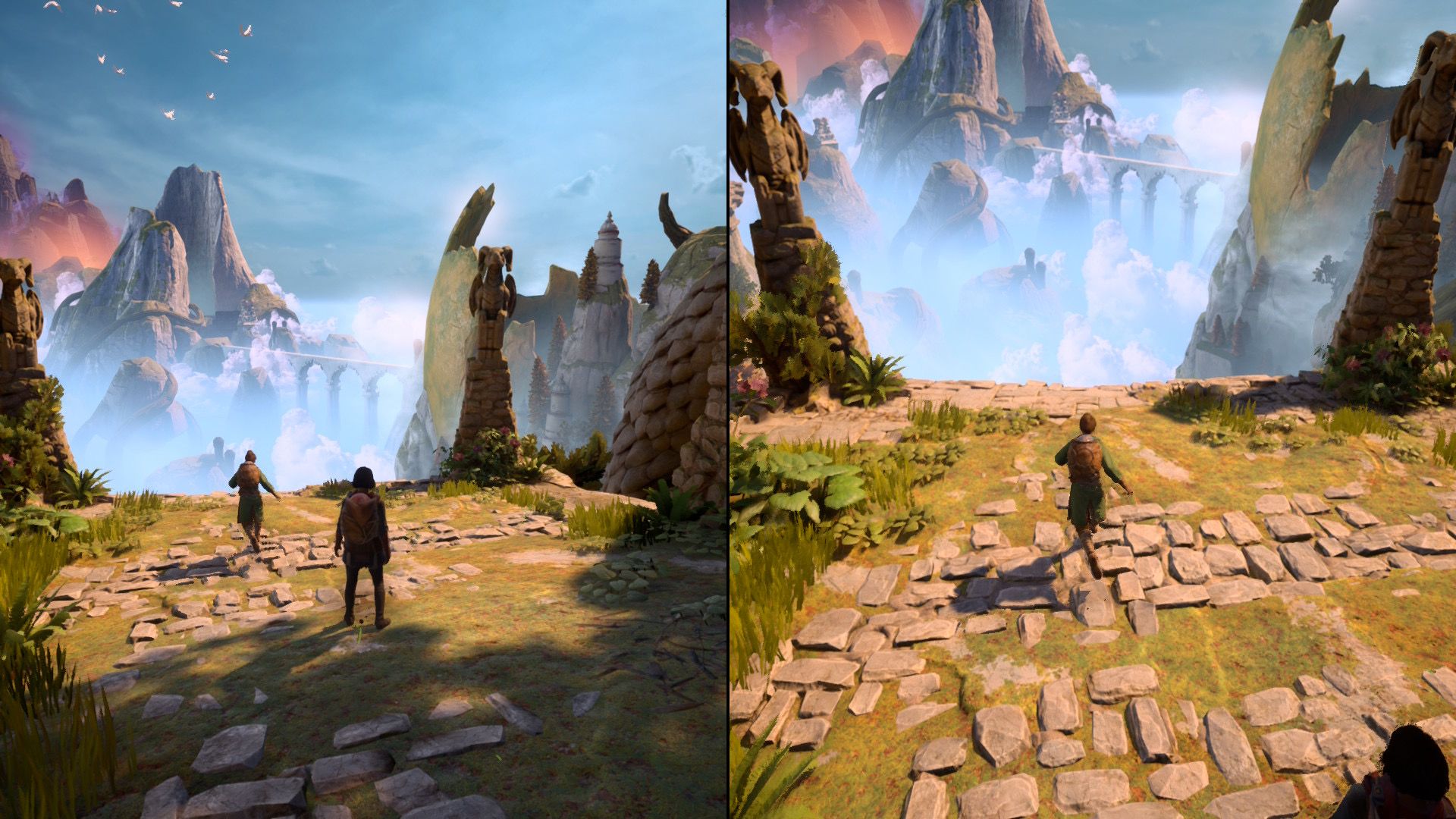
Split Fiction tells the story of two writers, Zoe and Mio, whose paths cross when they bump into each other at a the offices of a major “publishing” company called Rader. I put “publishing” in quotes there because as the two authors quickly discover, Rader is less of a book company and more of a shady, morally dubious technology company. The two pretty quickly discover they’ve been duped when they’re led into a chamber with a massive, spinning machine, are asked to put on jumpsuits and stand on totally-not-suspicious platforms. Turns out, the company has somehow developed the technology to send the writers into their stories, and intends to use The Machine (that’s literally what it’s called) to steal their stories. That’s right: the big bad in Split Fiction is committing the most nefarious crime plaguing modern society: copyright infringement!
Mio, who is decidedly not okay with having her ideas stolen, understandably tries to back out of the experiment. Unfortunately, an altercation with Rader’s CEO ends ends with her stumbling onto Zoe’s platform, trapping the two of them in suspended animation. As the machine boots up, the two women are whisked away into their own imaginations, where their stories have quite literally come to life. While Zoe’s stories are whimsical fantasy charades with some surreal elements scattered throughout, Mio’s are action-packed sci-fi thrillers filled with countless dangerous situations. Their worlds are connected together through glitches that were created when the Mio fell onto Zoe’s platform, and they quickly discover that they’ll need to work together to find and navigate through these glitches if they hope to escape The Machine.
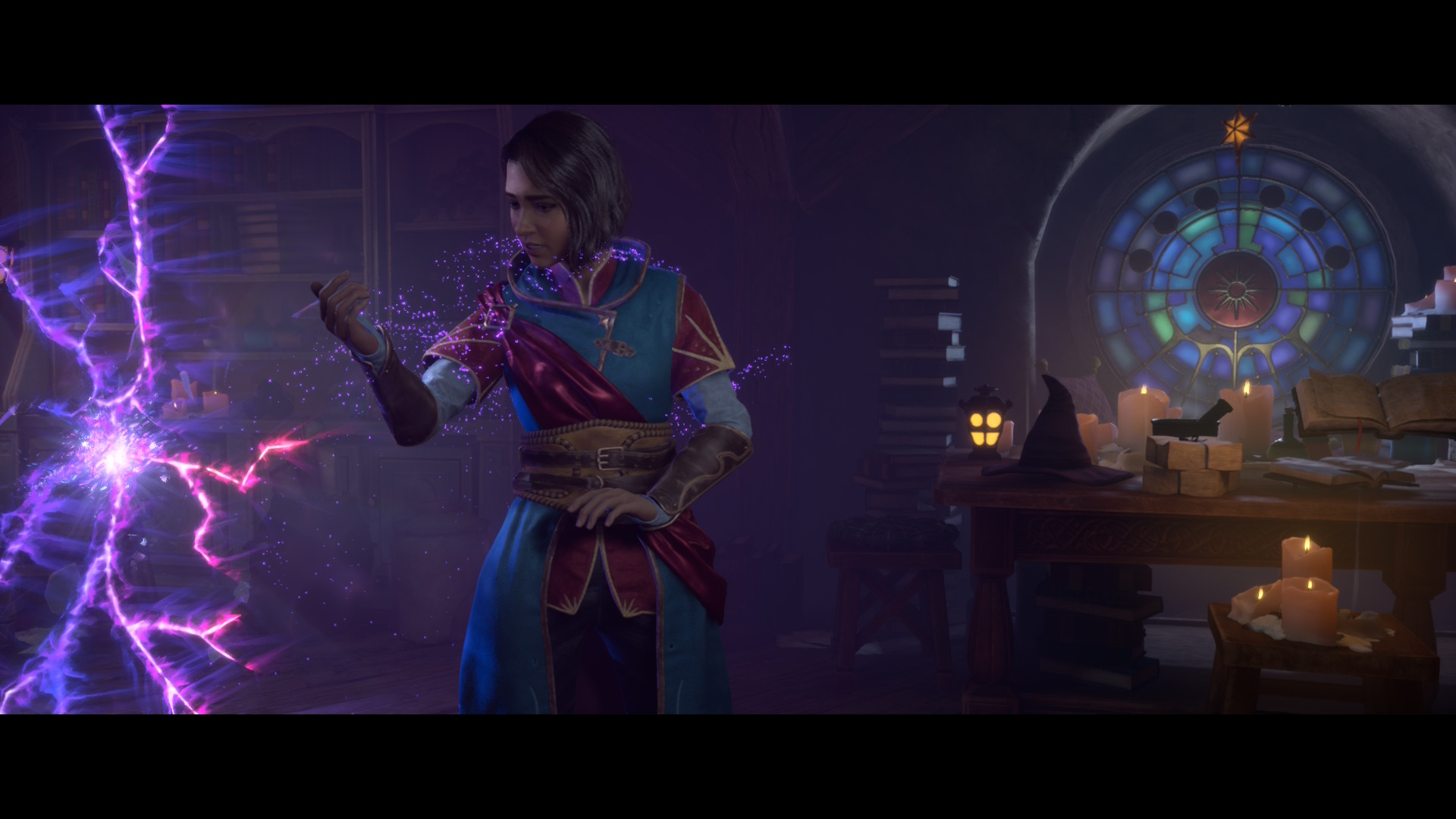
This premise was not really the reason why I wanted to play Split Fiction; I had watched the game’s trailers before launch, and what I had seen of the characters and the introduction to the story had not particularly intrigued me. Still, I tried to go into this game with an open mind, but at the start of my playthrough I was a bit put-off by what felt like a pretty by-the-numbers premise. The tropes pretty much write themselves: “Bad guy captures two unlikely protagonists, and they have to work together and put aside their differences to survive” is something most of us have seen many times before.
Split Fiction’s plot never really evolves beyond its core, somewhat cliche premise, but fortunately the characters do. While at the start, it can be just a little exasperating seeing Zoe and Mio clash in such predictable ways (who would have thought that the snarky, hardened writer would be impatient with her plucky, go-lucky partner), this improves. Over time the awkwardness of this dynamic fades, and the banter between the two slowly reveals more of their true personalities and why they became writers in the first place. I was never really surprised by the developments, but fortunately this game prefers not to bog the players down with cutscenes when it knows it doesn’t have too much to say. Split Fiction is okay with using its story beats less to captivate the player narratively, and moreso to create increasingly exciting and absurd gameplay scenarios to drop the protagonists into. Eventually, the story somewhat fades into the background entirely, and instead I found that most of the dialogue I was experiencing was between me and my wife, as we found ourselves working together (or trying to, anyways) to press through increasingly challenging stages.
At it’s core, Split Fiction is generally a game about doing a handful of things in different ways. There’s a lot of platforming, a lot of shooting stuff, and a lot of puzzle-solving. That would be the overly simplistic take, though, because the reality is that while most of Split Fiction’s gameplay falls into one of those three buckets, the trick this game pulls off is that you never feel like it’s making you do the same thing twice. The game manages this by taking a small but robust suite of core mechanics, adding to them, and then continuously reinventing itself through new types of challenges. You’re always working together, but the way in which you have to think, react or communicate with the other player always feels like it’s evolving.
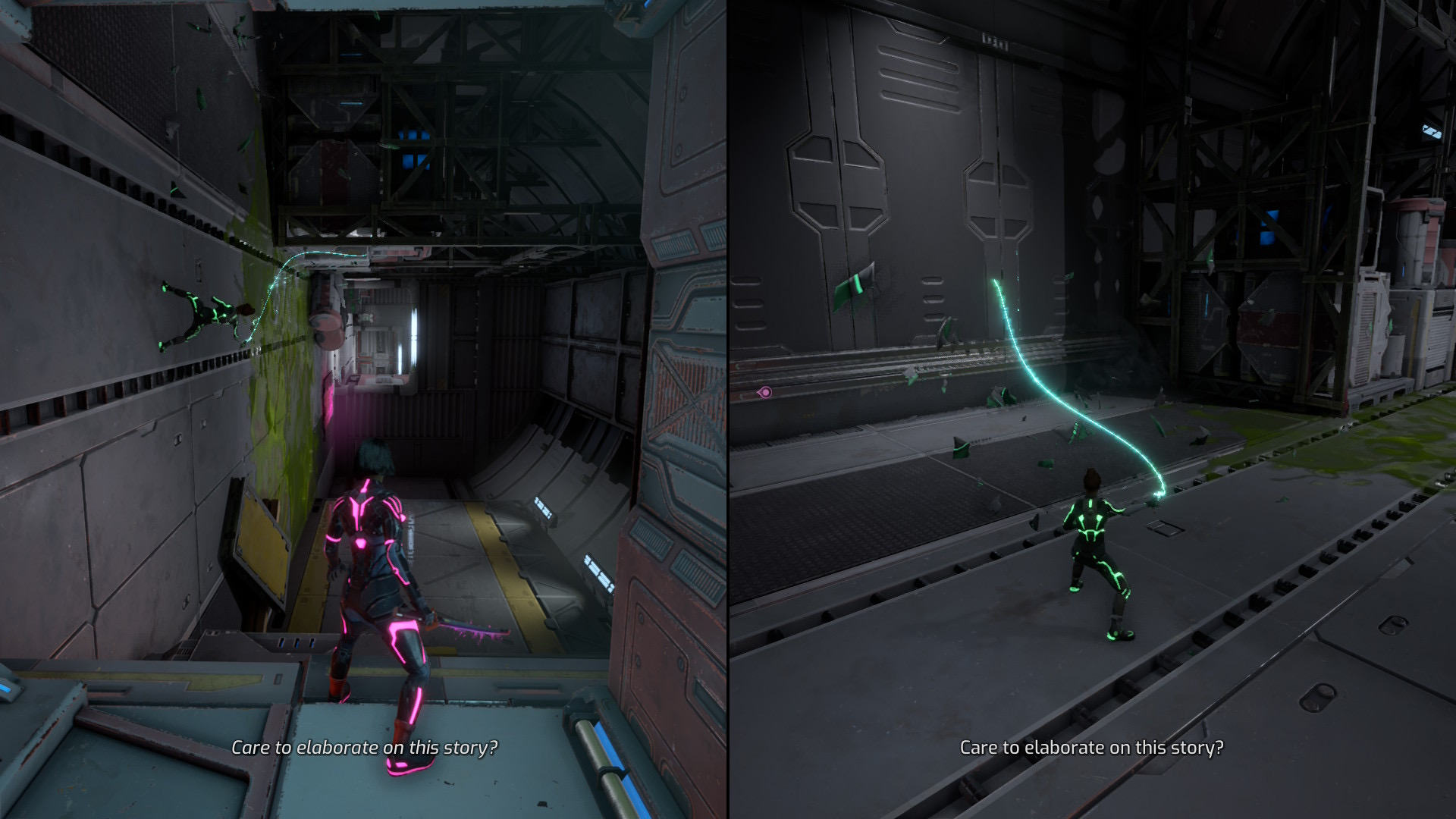
For example, while either player can jump, double jump, sprint and grapple, each player also generally has their own unique ability that is specific to the scenario that Zoe and Mio find themselves in. For example, in Mio’s dystopian sci-fi hellscape, there’s an early situation where the two assume the roles of “cyber ninjas” and use different abilities that correspond to their suits. Mio’s purple suit gives her the ability to shift gravity by zipping to certain platforms, which opens up new routes for her. Zoe, on the other hand, can wield a sort of telekinetic field that lets her catch and throw objects, either at enemies or at obstacles. It’s impossible to progress without both players not just learning how to use these tools, but also how to use them to help the other player, such as by navigating to a distant area and then clearing a new path forward.
But just as the players have mastered their unique skills, it’s typically not long at all before they’re whisked away to another world and given an entirely new set of skills to learn. After being transported to Zoe’s fantasy world early on, my wife and I both found that we could shape-shift into fantasy creatures, but we both had different ones. I was able to transform Mio into either an otter-like creature, letting me swim quickly in dangerous waters, or a gorilla who could climb on vines and bash things with his fists. My wife, on the other hand, could shift Zoe into either a Groot-like tree creature that could manipulate plant roots to create paths, or a fairy who could zip through the air across vast distances. Often, we would find ourselves in situations where we had to quickly switch back and forth between all these various forms with pretty precise timing required for us to progress. By the end of that part of the game – maybe two hours or so – we had felt we had mastered the mechanics. And then it was back to Mio’s sci-fi world, to learn another set of mechanics, and so on.
Then, sprinkled between these larger chunks of progression are side stories, which whisk the players away to shorter, optional experiences. These typically introduce a whole new set of mechanics, a wacky new art style, or both. I won’t spoil too many of these, as they’re some of the most fun and surprising parts of the game, but some highlights for me included a downhill snowboarding race through a crumbling warzone, and a journey through a storybook world that is being drawn into existence as you clamber through it. Some of the trickier ones were pretty frustrating for my wife, but luckily they can all be skipped if needed, although you probably won’t want to.
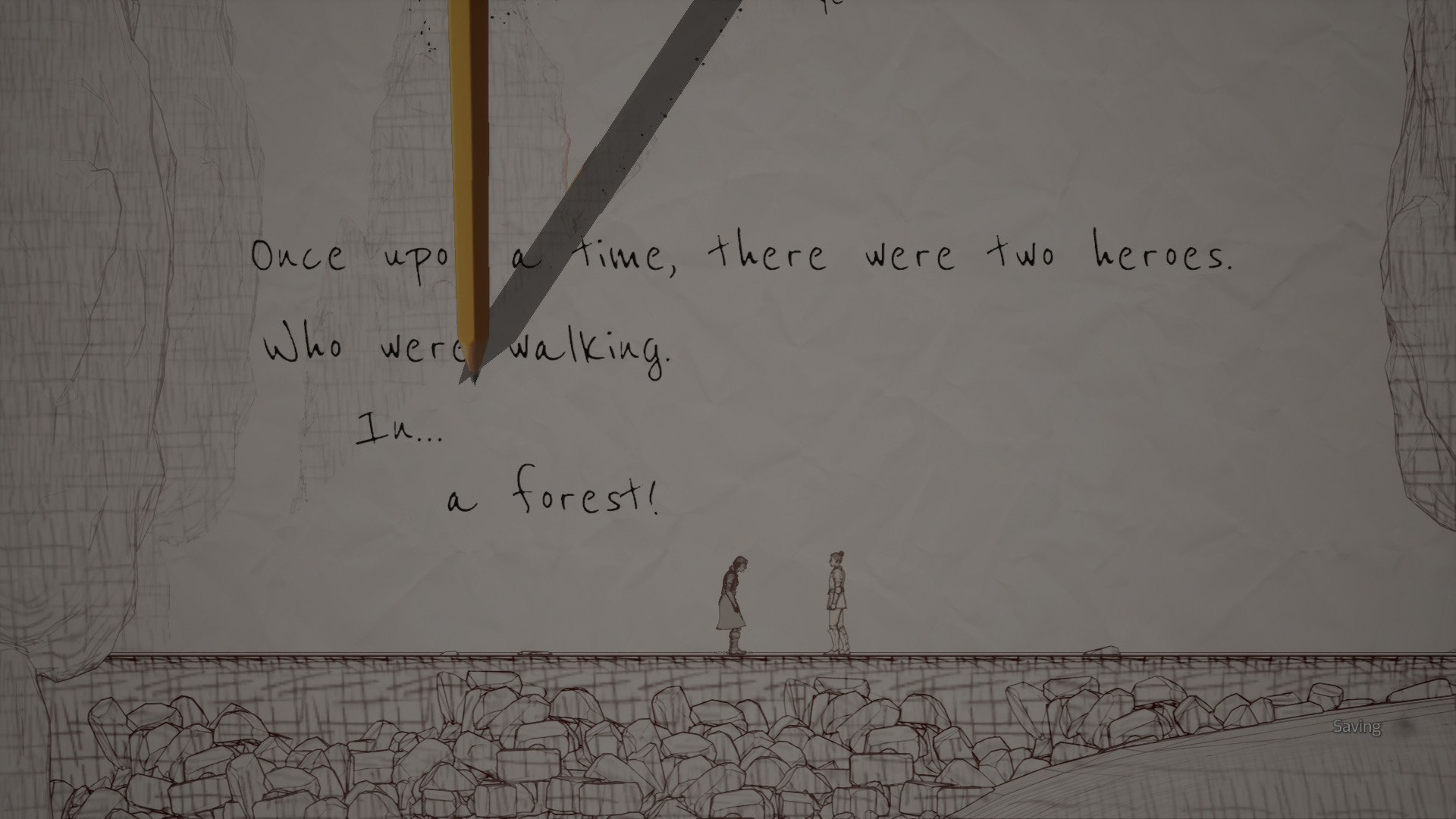
Beyond that, it’s difficult to understate just how much a thrill ride Split Fiction feels like at just about every second. At any given moment you could be riding dragons, or sneaking through a laser maze to infiltrate a space prison, or casting spells or shooting miniguns. I can honestly say that I was never bored while playing Split Fiction, which is an impressive feat as even games I love dearly are filled with moments that will have me saying to myself, “can we please move on now?” There was also, to this game’s credit, never a point where it felt like any of these ideas had been phoned in. Mechanically it’s all somewhat simple to wrap your head around if you play games often, even despite the pace at which the game tends to throw things at you.
A huge highlight for me was the game’s boss battles, which are exactly the epic, action-packed experiences you’d hope they would be. There are a ton of them scattered across the game, and they all successfully manage to act as a “final exam” of sorts for the mechanics you’ve (hopefully) already mastered during that section of the game, while also being incredible experiences in their own right. They often can be pretty nail-biting to play through, with some bosses filling the screen with an array of projectiles and smaller enemies to dodge and shoot, and typically multiple phases in which to try and survive. They get pretty wild conceptually, too. My favorite was easily a multi-stage battle with a massive, robotic overseer that was also a parking attendant. It wanted to eviscerate us for unpaid parking fines, while also screaming vehicle puns at us the entire time and destroying the parking garage we were desperately sprinting through. It threw a bus at us, several times. It was awesome.
I will offer the caveat that this game does feel more difficult than both A Way Out and It Takes Two, which may create some headaches if you’re playing with a less experienced co-op partner. They boss battles in particular typically demand even tighter reflexes and speed than the rest of the game, and for us, death was a frequent occurrence. Luckily, as long as one player is still alive the other will respawn fairly quickly, but there will be plenty of yells of “please don’t die, please don’t die” in that span of time. Fortunately, the developers did a great job with this game’s checkpointing system, which means we rarely lost more than a minute or two of progress when we did both fall off a ledge or get crushed by poorly-placed industrial machinery. My wife was also grateful for an accessibility option that lowered the amount of incoming damage from foes, as while she’s great at puzzle-solving, combat is more stressful for her to navigate.
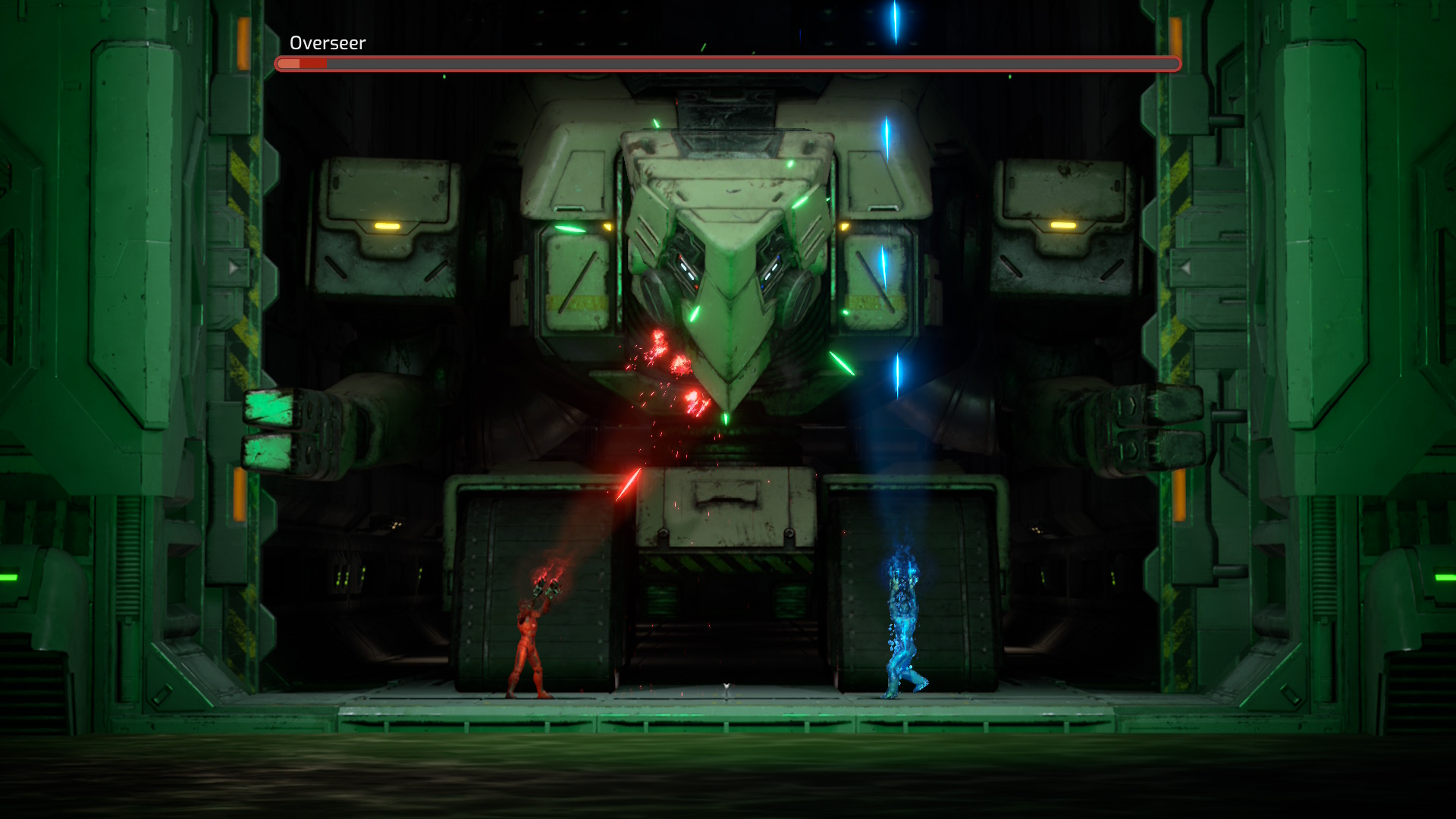
Overall, Split Fiction looks and runs great on the Nintendo Switch 2, in this writer’s opinion. While it doesn’t hit above 1080p, it’s still a great looking game from edge to edge. Environments are detailed, with sharp textures, convincing lighting and dynamic shadows. Character models look a bit soft in some of their facial details, but overall visually look very comparable to what other platforms are able to achieve. And while the game doesn’t run above 30 frames per second, it’s a very stable frame rate in my experience, with only minor drops popping up here and there. One major downside is that this game has a chunky 70GB file size, which is almost 1/3 of Nintendo Switch 2’s onboard storage space, so you likely won’t be leaving this one on your console for very long after your first playthrough.
While it’s technically possible to play this game in tabletop mode in local co-op, I wouldn’t necessarily recommend it as there are a lot of moments in Split Fiction where the characters are pretty far from the camera, and playing on a smaller screen could make this more difficult. This is a game that really shines on the TV with someone sitting next to you, although with Switch 2’s new GameChat feature working at the system level, I could see online play being really fun with the right person as well.
I did also test out playing Split Fiction with Nintendo Switch 2’s GameShare feature, which lets someone who owns the game on Switch 2 stream a gameplay session to another Switch 2 or Switch 1 console, as long as both systems are near each other. This didn’t work all that well for us when trying to send a session to a Nintendo Switch 1 console, as even with both devices in the same room, perhaps ten feet apart, the Switch 1 experienced significant artifacts and latency when streaming the game. I’m not exaggerating when I say it was just about unplayable. I’ll caveat that this might work better between two Nintendo Switch 2 consoles give the better network cards in the new generation of systems, but I wasn’t able to test at that level.
Split Fiction is a thrill ride that will keep two players entertained for hours, filled to the brim with inventive gameplay ideas, exciting boss battles, and clever co-op dynamics that few games these days dare to attempt. While the story is cliche and serves little purpose beyond driving the action forward, the game never bores thanks to its enrapturing set pieces, visual flair, and creative concepts around every turn. Try not to bicker too much when things get difficult, but with the right person sitting next to you, you’re all but guaranteed to have a great time with this one.
Split Fiction copy provided by the publisher for the purposes of this review.
